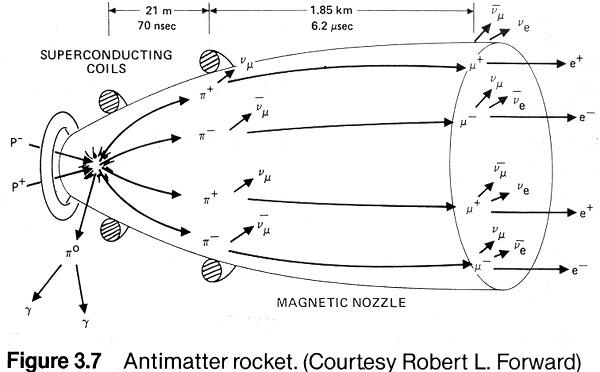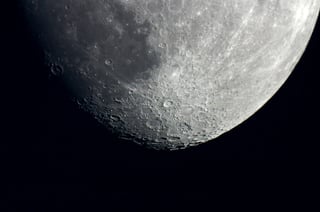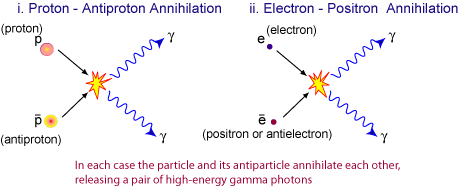Contrary to L.Dutch's statement above, annihilation of baryons eventually produces only gamma rays, but in the short-to-medium term you get all sorts of interesting daughter particles not all of which are unstable. Only electron-positron annihilation gives you nothing but gamma rays.
According to the source of all knowledge:
Thus, when a proton encounters an antiproton, one of its quarks, usually a constituent valence quark, may annihilate with an antiquark (which more rarely could be a sea quark) to produce a gluon, after which the gluon together with the remaining quarks, antiquarks, and gluons will undergo a complex process of rearrangement (called hadronization or fragmentation) into a number of mesons, (mostly pions and kaons), which will share the total energy and momentum.
In a vacuum, these annihilation products can travel quite some distance before they decay into gamma rays or stable particles such as electrons and positrons:

The mostly likely reaction involves the production of some neutral pions (shown as π0) which decay almost immediately into high-energy gamma rays, and also some charged pions (shown as π+ and π-) which have a short lifetime but are also travelling exceedingly fast and can therefore interact with nearby matter. The pions decay into charged muons (shown as μ+ and μ-) which are even more stable, and can travel for quite some distance in a vacuum. These, too, can interact with surrounding matter. The pions eventually decay into electrons and positrons (shown as e+ and e- respectively), the latter of which can annihilate an electron either produced by the decay chain or in surrounding matter producing more gamma rays
Those early charged pions have a kinetic energy of >200MeV, which does exceed the atomic binding energy of most light elements. The interaction cross section with a nucleus will be small, and the chances of the pion scattering off the nucleus will be reasonable, but some proportion of nuclei in the matter surrounding the blast might in fact be fissioned. Similarly, the >200MeV gamma rays coming out of neutral pion decays can also cause photodisintegration of nuclei.
Certainly, nuclei as light as aluminium might be smashed up by this process... possibly slightly heavier nuclei too, but I'm unclear on that. The resulting fragments may be radioactive, and they may be long lived unstable isotopes. The amount of induced radioactivity is obviously going to be nonzero, but it isn't clear how much there will be (and the question might be too hard to answer).
An uncontrolled release of bulk antimatter is also going to result in some of it being blasted away from ground zero by radiation pressure without necessarily being annihilated immediately, as you'd want if it were an antimatter rocket or warhead.
This means you've got an expanding shell of ionised antimatter that can also interact with surrounding material. Individual antiparticles will eventually interact with a matter particle, but obviously a single antiproton or antineutron cannot annihilate anything larger than a hydrogen-1 atom. Anything larger will end up being being transmuted into a different isotope or element, and the resulting release of energy by the annihilation will be soaked up by spectator nucleons which may in turn cause the atom to fission.
Does the site still glow because of daughter isotopes
Normal nuclear blasts don't have a radioactive glow in the aftermath, and antimatter blasts are no more likely to produce such an effect.
There's some scope for long-lived radioactivity, but in the absense of neutron activation and waste actinides from any fission byproducts, it seems likely that it will be much less. Even more so for the moon which has less metal than the Earth does, given its lower density, and it is often metals in the soil and rocks that undergo neutron activation to produce that long lived background radiation after a nuclear explosion.
or is it simply a big hole in the ground, how far would the debris be spread etc...
Some of the debris will certainly exceed local escape velocity. It will likely hit Earth, though I suspect that with only a tonne of antimatter (equivalent yield 40 GT) there won't be enough to cause an exciting meteor shower. The flash will probably be visible to the naked eye if you were looking in the right direction, and there might be some satellite casualties from debris.
You'll get little tiny bits scattered all around the moon's surface, but mostly what you'll get will be a nice big hole, not too unlike the other nice big holes already there.
Regarding the possiblity of a moon-shattering kaboom raised by the square-cube law, consider Tycho crater:

Its a biggun... >80km across, and clearly visible from Earth (possibly with the aid of binoculars, if your eyes aren't great, but even so) but there are plenty of larger craters on the Moon, which remains resolutely intact.
I wasn't able to find much good research on the nature of the Tycho impactor, but having a fiddle with the charmingly old-school-looking lunar crater simulator, I was able to come up with something about 12km across and travelling at about 15km/s for a total kinetic energy of ~1.5 x 1023J, or ~36 teratonnes TNT equivalent. Even if it were wrong by two whole orders of magnitude, that's still a much bigger boom than the antimatter cooking off, and it'll do a much better job of shovelling regolith and rock around.
A tonne of antimatter will make a fearsome blast, but still small beans compared to a reasonably sized space rock. The moon isn't going anywhere.




